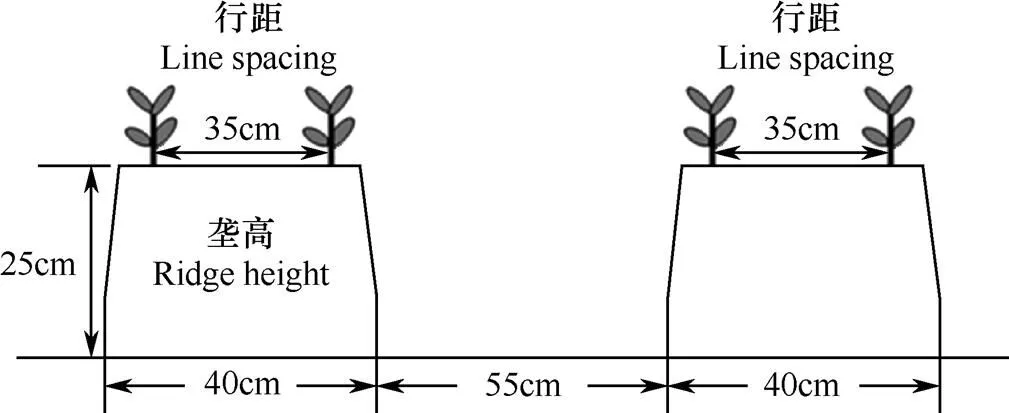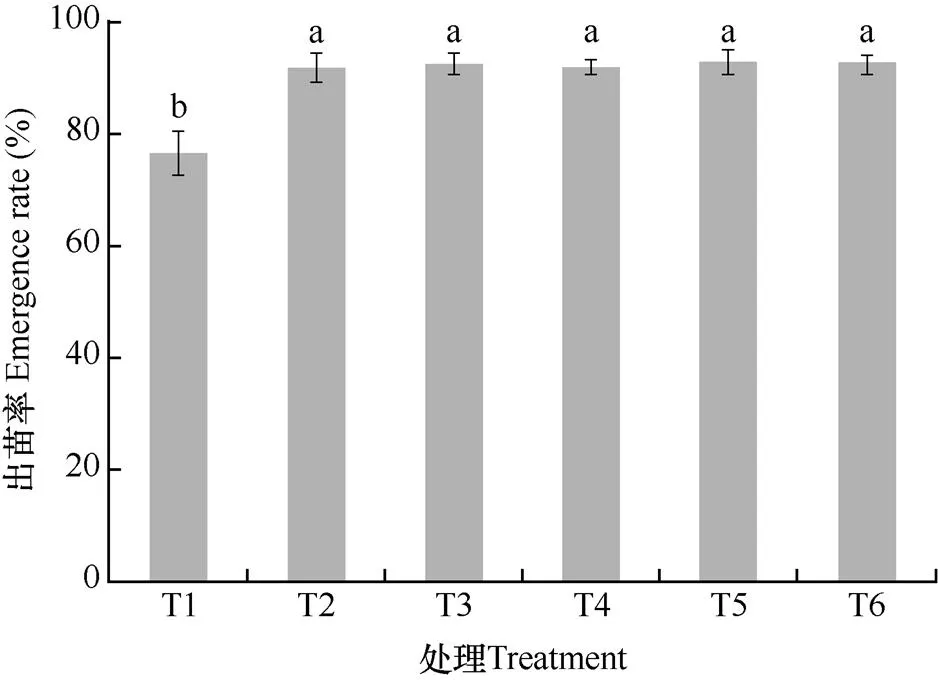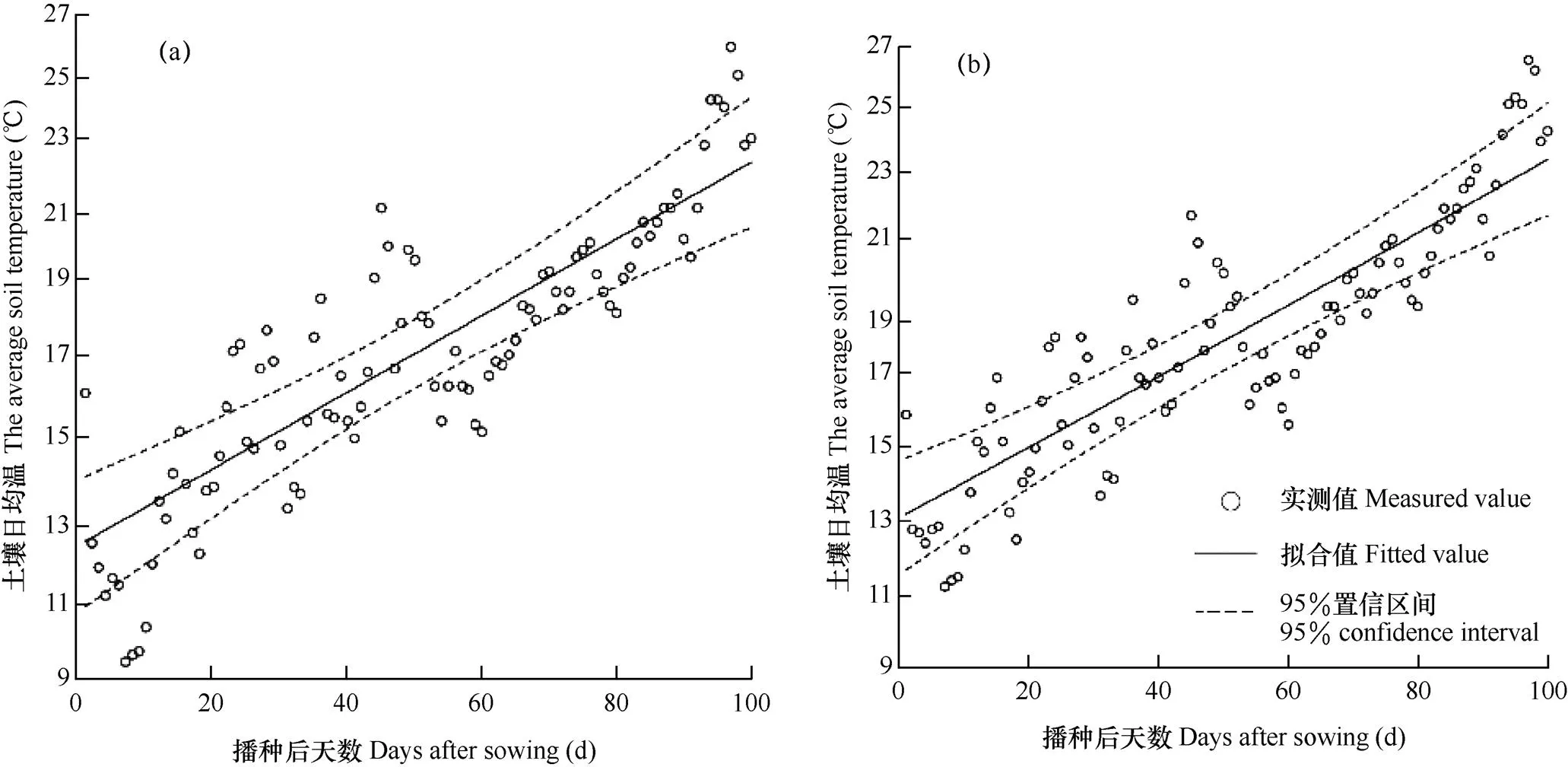华北集约农区马铃薯地膜覆盖安全期的探讨*
2018-03-19秦丽娟李海萍严昌荣
秦丽娟,李海萍,刘 秀,严昌荣**
华北集约农区马铃薯地膜覆盖安全期的探讨*
秦丽娟1,2,李海萍3,刘 秀1,2,严昌荣1,2**
(1.中国农业科学院农业环境与可持续发展研究所,北京 100081;2.农业部农膜污染防控重点实验室,北京 100081;3.青岛市农业环保能源工作站,青岛 266071)
作物地膜覆盖安全期指某一作物在某一区域要求地膜覆盖的最佳天数,也就是地膜覆盖农田土面能保持膜面完整的日数,在此日数之前地膜应该保持基本完整,维持增温保墒等功能,此日数之后,这些功能基本消失。华北集约农区水分条件基本能满足马铃薯生长的需求,因此,生产中主要根据该区域自然条件和作物对温度需求的特点适期揭膜。为确定华北集约农区马铃薯种植的最佳揭膜时间,在青岛市以露地种植为对照(T1),分别设置了播种后覆膜30d(T2)、60d(T3)、75d(T4)、90d(T5)4个中途揭膜和全生育期覆膜不揭(T6)共6个处理,观测田间10cm土层土壤温度以及马铃薯生育期、出苗率及产量等指标。结果发现:与露地(T1)相比,地膜覆盖(T2、T3、T4、T5和T6)可以促使研究区马铃薯提前5d出苗,且出苗率得到提高;全生育期覆膜(T6)通过提高地温从而促进马铃薯的生长发育,在马铃薯播种-出苗期,全生育期覆膜(T6)处理较露地(T1)10cm土层土壤日平均温度提高1.1℃,10cm土层地积温增加66.1℃·d。不同揭膜时间的试验结果显示,在播种后60d揭膜处理中,马铃薯田10cm土层的地积温较高,为1795.6℃·d。此外,在马铃薯播种60d内地膜覆盖可以显著提高马铃薯田10cm土层地温日较差,播种60d后揭膜对10cm土层地温日较差影响不大。研究结果显示马铃薯产量与地膜覆盖和揭膜时间密切相关,对照露地种植(T1)产量最低,为40.3t×hm−2;60d揭膜(T3)最高,为45.7t×hm−2,较露地种植(T1)增产13.4%;75d揭膜(T4)较高,较露地种植(T1)增产10.4%。综合看,在该地区马铃薯生产中覆膜后60~75d进行揭膜最合适,即该地区马铃薯地膜覆盖安全期为60~75d。
马铃薯;地膜覆盖;揭膜;安全期
地膜是农业生产的重要物资之一,它的应用带动了中国农业生产力的显著提高,对保障中国粮食安全做出了重大贡献[1]。地膜覆盖使作物种植的海拔高度增加,适种范围扩大,产量提升[2]。在干旱半干旱地区,水分和温度是限制农业生产的主要因素,地膜覆盖可以显著改善耕层土壤水热状况[3-4]。在华北集约农区良好灌溉条件下,早春低温则是制约作物生长的主要因素。在作物生育前期,地表覆盖稀疏,地膜覆盖增温效果显著,可提高作物幼苗成活率并促进作物生长发育。但在作物生育中后期,由于气温升高和作物冠层覆盖大,地膜覆盖增温功能大为降低或者基本消失。也有研究结果显示延长覆膜时间可能导致作物早衰,增加地膜与土壤的黏附性,增加揭膜的机械阻力和破损程度,降低地膜回收率,加重农田地膜残留污染[5]。基于此,有研究提出作物地膜覆盖安全期的概念,即正常的自然条件和农事操作下,作物在某一区域要求地膜覆盖营造温度、水分等环境的最佳天数,超过这一天数,地膜覆盖会对作物生理或农田生态环境产生负效益[5-6],应根据区域自然条件和作物对温度、水分等需求特点,进行适期揭膜,促进作物生长发育和提高地膜回收率。
由于区域自然条件和田间水肥管理水平的不同,在马铃薯生产中,地膜覆盖的目的和作用存在差异。在北方旱作区,马铃薯地膜覆盖的主要功效是保墒和前期增温[7-10];在东南丘陵地区,马铃薯地膜覆盖主要目的是为了防除杂草和提高早期温度,应在马铃薯播种后45d进行揭膜,以实现马铃薯苗期增温和防止过晚揭膜造成地温过高(超过30℃),抑制马铃薯生长和降低产量[11-12];在华北集约农区,马铃薯田具有良好的灌溉条件,温度是影响该区域马铃薯生长的重要环境因子[13]。近年来,华北地区马铃薯种植面积逐渐扩大,正在成为中国马铃薯重要产区,地膜覆盖也是马铃薯生产中采用的主要农艺技术之一,已有研究结果显示地膜覆盖能显著提高土壤温度,使马铃薯产量增加30%以上,具有很好的经济效应[14-15]。但如何合理利用地膜覆盖技术还有待加强,如普通PE地膜是否需要揭膜,揭膜最佳时机等。本研究试验在山东青岛进行,通过地膜覆盖和不同揭膜时间的处理对马铃薯田土壤温度、马铃薯生长发育和产量的影响,研究华北地区马铃薯生产过程中地膜的最佳揭膜时间,确定马铃薯地膜覆盖安全期,为华北集约农区合理利用地膜覆盖进行马铃薯生产提供科学依据。
1 材料与方法
1.1 试验地概况
试验地位于山东省青岛胶州市胶西镇石家河崖村,地理位置为36°15′N,119°51′E,海拔31m。该地区属暖温带东亚湿润季风型大陆气候,年平均气温14.1℃,极端高温36.5℃,极端低温−9.2℃,≥10℃积温4520.3℃·d,年降水量686.5mm,日照时数2170.5h,无霜期205.5d。土壤为棕壤土,容重1.37g·cm−3,pH4.6~5.6,有机质含量12.8g×kg−1,碱解氮82mg×kg−1,有效磷41.3mg×kg−1,速效钾95mg×kg−1。
该地区主要种植作物为玉米、小麦、马铃薯和蔬菜等,一年两熟。近年来,马铃薯种植面积逐渐扩大,年播种面积达到4万hm2以上[13]。马铃薯一般在3月中下旬播种,6月底或者7月初收获。由于早春气温较低,马铃薯生产中均进行地膜覆盖。
1.2 试验材料
试验用地膜为普通无色聚乙烯地膜,厚度8mm。种植马铃薯品种为“荷兰15号”。
1.3 试验设计
试验设6个处理:以马铃薯全生育期露地种植为对照(T1);播种后覆膜,播种30d(T2)、60d(T3)、75d(T4)、90d(T5)后揭膜;全生育期覆膜,不揭膜(T6)。每个处理3次重复,随机区组排列。
种植方式:垄作,全垄覆膜,垄宽95cm,高25cm,长60m(图1)。每垄种植2行,行距35cm,每小区设一垄,面积为57m2。小区设在大田中,小区两侧设4垄保护行。

图1 青岛马铃薯覆膜种植试验示意图
播种和覆膜:2016年3月18日人工播种,用覆膜机进行地膜覆盖,为实现马铃薯自动破膜出苗,4月2日进行膜上覆土,覆土厚度3~5cm,6月27日收获。
揭膜方式:采用人工揭膜方式,在30d揭膜时,马铃薯植株矮小只需清除膜面上的泥土便可揭膜;在60~90d揭膜时为免植株受损,先清除膜面泥土,然后用镰刀沿马铃薯种植方向割开地膜,再清除地膜。
1.4 田间管理
施肥:播前一周按当地种植习惯,结合整地施马铃薯专用基肥,各处理肥料用量一致,分别为N 180kg×hm−2、P2O570kg×hm−2、K2O 200kg×hm−2。在5月7日、6月10日分别追施复合肥,各处理肥料用量一致,分别为N 90kg×hm−2、P2O530kg×hm−2、K2O 150kg×hm−2及N 96kg×hm−2、P2O536kg×hm−2、K2O 216kg×hm−2。
水分管理:马铃薯生育期内降水为399.0mm,同时,分别于2016年4月22日、5月7日、5月30日、6月3日和6月11日灌溉5次,灌溉方式为沟灌,每次灌水量20mm,马铃薯整个生育期的总水量为499mm。
病虫害防控:2016年3月15日,喷洒浓度为30%的毒死蜱,剂量为3.8kg×hm−2。2016年6月9日,喷洒浓度为25%的阿米西达,剂量为300mg×hm−2。
1.5 观测指标和方法
1.5.1 土壤温度
采用HIOKI LR5011-20温度测定仪,自动监测马铃薯全生育期土壤温度,仪器精度0.1℃。每个小区埋设1个温度传感器,埋设位置为垄面,埋设深度为膜下10cm。数据时间间隔为30min,从覆膜当日起连续测定直至马铃薯收获。
土壤日平均温度为每日48个10cm土层瞬时温度数据的平均值。地温日均差为每日10cm土层地温最高值与最低值之差。已有研究显示,土壤日平均温度10℃为马铃薯生长的下限温度[16],计算各生育阶段土壤日平均温度≥10℃持续期间的土壤温度总和,得出各阶段土壤≥10℃积温(<10℃的土壤日均温度计为0℃)。
1.5.2 马铃薯产量
采用人工收获方式,在每个处理的3次重复小区,各选一个小区,取长10m垄面,称量马铃薯鲜重,称量前仔细去除马铃薯上的泥土。
1.5.3 数据分析
使用SigmaPlot 12.5软件分析覆膜对马铃薯出苗率的影响及揭膜时间对马铃薯产量的影响。
使用R语言mgcv中的gamm函数建立广义线性可加模型[17-19],分析全生育期覆膜和露地马铃薯农田10cm土层日平均温度及温差情况。
使用Excel2010及SAS9.2软件分析揭膜时间对马铃薯各生育期内农田土壤≥10℃积温和地温日较差的影响。
2 结果与分析
2.1 不同时间揭膜对马铃薯生长发育的影响
2.1.1 对生育期的影响
由表1可见,露地种植(T1)马铃薯于播种后27d左右出苗,覆膜处理(T2、T3、T4、T5和T6)在播种后22d左右出苗,与露地(T1)相比,覆膜使马铃薯出苗期提前5d左右。此外,覆膜处理(T2、T3、T4、T5和T6)中马铃薯现蕾期、盛花期、茎叶衰老期及收获期均较露地种植(T1)提前2~4d,但不同时间揭膜各处理中生育期间无显著差异。说明地膜覆盖可以加快马铃薯生长,缩短马铃薯生育期,而中途揭膜不影响其发育进程。
2.1.2 对出苗率的影响
出苗率是马铃薯栽培是否成功的基础,并最终影响产量。如图2所示,覆膜处理(T2、T3、T4、T5和T6)马铃薯出苗率均显著高于露地种植(T1),且各覆膜处理间无显著差异。说明覆膜可以显著提高马铃薯出苗率,但由于揭膜处理均在出苗期之后进行,故揭膜时间对出苗率无显著影响。

表1 不同处理马铃薯生育进程的比较(月-日)
Note: T1 is the planting potatoes without plastic film; T2, T3, T4 , T5 is the planting potatoes with plastic film and removing film after 30d, 60d, 75d, 90d , respectively; T6 is the planting potatoes with plastic film for the entire growth period. The same as below.

图2 不同处理马铃薯出苗率的比较
注:小写字母表示处理间在0.05水平上的差异显著性。短线为误差线。下同
Note: Lowercase indicates the difference significance among treatments at 0.05 level. The bar is the error line.The same as below
2.2 不同时间揭膜对10cm土层土壤温度的影响
2.2.1 全生育期不揭膜
由图3可见,与露地处理(T1)相比,在马铃薯全生育期内地膜覆盖(T6)比露地种植(T1)的10cm土层土壤日均温度高0.6℃,其中播种-出苗(播种后0~27d)马铃薯农田地膜覆盖比露地(T1)10cm土层土壤日平均温度高1.1℃,出苗-收获地膜覆盖比露地(T1)10cm土层土壤日平均温度高0.4℃,表明在马铃薯生长前期,地膜覆盖的土壤增温效果较后期更为明显。
由表2可见,全生育期覆膜(T6)比露地处理(T1)条件下马铃薯各生育期10cm土层土壤积温均有增加,其增幅表现为播种-出苗(21.8%)>出苗-现蕾(2.8%)>现蕾-盛花(2.1%)>茎叶衰老-收获(1.7%)>盛花-茎叶衰老(1.5%),表明随着生育期的推进,地膜覆盖的增温效果逐渐减弱。播种-出苗地膜覆盖相对于露地处理(T1)10cm土层土壤积温增加最多,为66.1℃·d,较其它生育期土壤积温增幅大,即地膜覆盖对马铃薯田10cm土层土壤积温的增加作用主要集中在播种-出苗期。

图3 马铃薯全生育期露地(a)与覆膜(b)处理中10cm土层土壤日平均温度的比较

表2 马铃薯全生育期内覆膜(T6)与露地(T1)处理中10cm土层≥10℃积温的比较
注 :A表示露地全生育期土壤积温,B表示全生育期覆膜处理中的土壤积温。
Note: A is the accumulated temperature of soil of non-mulching during the whole growth period,B is the accumulated temperature of soil of mulching during the whole growth period. The same as below.
图4表明,在马铃薯生育前期,全生育期覆膜(T6)与露地(T1)10cm土层日均土壤温差较大,随着时间的推移,两种处理的温差越来越小,覆膜后70d左右覆膜与露地10cm土层日均土壤温差趋近于0,这表明该地区马铃薯地膜覆盖增温作用消失的时间节点为覆膜后第70天左右。
2.2.2 中途揭膜
由表3可见,马铃薯播种后30d内,有覆膜处理(T2、T3、T4、T5及T6)10cm土层≥10℃积温显著高于露地(T1),覆膜处理(T2、T3、T4、T5及T6)农田10cm土壤积温较露地(T1)高64.3~68.1℃·d,主要是由于马铃薯苗期气温低,地表覆盖稀疏,太阳光可以直射膜面,地膜增温效果显著;播后31~60d土壤温度数据显示,60d及以后揭膜(T3、T4、T5及T6)土壤温度显著高于露地(T1)和30d揭膜(T2),各处理土壤积温较露地(T1)高13.0~17.2℃·d,较30d揭膜(T2)高11.3~15.5℃·d;而播种61d后继续覆膜对土壤的增温作用不显著。表明该地区地膜覆盖对土壤的增温作用主要集中播种后60d内,随着马铃薯生育进程的推进,地膜覆盖的增温效应减弱。
由表4可见,马铃薯播后1~30d内有地膜覆盖的处理(T2、T3、T4、T5及T6)10cm土层地温日较差显著高于露地种植(T1),一般在1.5~1.7℃,这主要是由于早春地膜覆盖蓄热增温作用导致的。同样,60d后揭膜各处理(T3、T4、T5和T6)日较差显著高于露地种植(T1),高于30d揭膜处理(T2)但增温不显著,表明马铃薯播种60d内地膜覆盖仍然可以显著增加10cm土层地温日较差,但超过60d后不同时间揭膜则对地温日较差影响不大,各处理差异不显著。

图4 马铃薯全生育期内覆膜(T6)与露地(T1)处理中10cm土层土壤日平均温度之差

表3 不同时段各处理10cm土层≥10℃积温的比较(℃·d)

表4 不同时段各处理10cm土层地温日较差的比较(℃)
注 :日较差=最高温度-最低温度。
Note: Daily range = maximum temperature−minimum temperature.
2.3 不同时间揭膜对马铃薯产量的影响
马铃薯产量是各种农艺措施的综合反映,在其它栽培管理措施完全一致的条件下,不同时间揭膜影响土壤温度,间接影响到马铃薯的生长发育,最终影响产量。图5显示,在华北集约农区,露地种植(T1)马铃薯产量最低,为40.3 t×hm-2;各揭膜处理马铃薯产量均显著高于T1(P<0.05),其中60d揭膜(T3)产量最高,为45.7t×hm-2,较T1增产13.4%;75d揭膜(T4)马铃薯产量较高,为44.49t×hm-2,较T1增产10.4%。说明在华北集约农区为保证马铃薯产量,在60d(T3)和75d(T4)之间揭膜较好。

图5 不同处理下马铃薯产量的对比
3 结论与讨论
(1)地膜覆盖对华北集约农区早春马铃薯生产具有重要作用。地膜覆盖作为一种重要的农艺技术广泛应用于农业生产,研究发现,地膜覆盖对华北集约农区春马铃薯的生产具有极大影响,不仅反映在马铃薯的出苗率、生长状况方面,对马铃薯的产量也具有显著影响。地膜覆盖可以促使马铃薯提前5d左右出苗,且马铃薯出苗率显著高于露地种植;露地种植的马铃薯产量显著低于地膜覆盖的马铃薯产量,这与其它区域的研究结果相一致[20]。
(2)地膜覆盖对华北集约农区早春马铃薯的影响机理与西北旱地马铃薯存在差异。在西北地区,地膜覆盖的保墒、增温和防除杂草的功能是影响马铃薯生产的关键因素,尤其是保墒作用[21]。而在华北集约农区,由于是灌溉农田,水分条件基本能满足马铃薯生长的需求,地膜覆盖在马铃薯早期的增温作用最为重要,在马铃薯播种-出苗期的增温作用显著,在此阶段地膜覆盖较露地种植的10cm土层土壤日平均温度高1.1℃,10cm土层的地积温提高66.1℃·d。
(3)揭膜时间对华北集约农区马铃薯生长具有重要影响。在马铃薯生育前期,地膜覆盖能够提高土壤温度,减轻早春低温对马铃薯生长发育的影响,促进马铃薯生长发育。但在马铃薯生育中后期,由于马铃薯是喜凉作物,需及时揭膜[22-23]。播后60d揭膜增温效果显著,马铃薯农田土壤积温高出露地种植96.5℃·d,10cm土层地温日较差高出露地种植4.9℃。播后60d揭膜马铃薯产量最高,较露地马铃薯增产13.4%;75d揭膜马铃薯产量较高,较露地马铃薯产量增产10.4%。在华北集约农区,播后60~75d揭膜可以提高耕层土壤温度,增加地温日较差,促进马铃薯生长和发育。
因此,在综合考虑农业生产条件、覆膜功效以及马铃薯产量的基础上,该地区马铃薯地膜覆盖安全期在60~75d。
[1]何文清,严昌荣,赵彩霞,等.我国地膜应用污染现状及其防治途径研究[J].农业环境科学学报,2009,28(3):533-538.
He W Q,Yan C R,Zhao C X,et al.Study on the pollution by plastic mulch film and its countermeasures in China[J].Journal of Agro-Environment Science,2009,28(3):533-538.(in Chinese)
[2]严昌荣,何文清,薛颖昊,等.生物降解地膜应用与地膜残留污染防控[J].生物工程学报,2016,32(6):746-760.
Yan C R,He W Q,Xue Y H,et al.Application of biodegradable plastic film to reduce plastic film residual pollution in Chinese agriculture[J].Chinese Journal of Biotechnology,2016,32(6): 746-760.(in Chinese)
[3]李世清,李凤民,宋秋华,等.半干旱地区地膜覆盖对作物产量和氮效率的影响[J].应用生态学报,2001,12(2):205-209.
Li S Q,Li F M,Song Q H,et al.Effect of plastic film mulching on crop yield and nitrogen efficiency in semiarid areas[J]. Chinese Journal of Applied Ecology,2001,12(2):205-209.(in Chinese)
[4]张哲,孙占祥,张燕卿,等.秸秆还田结合秋覆膜对半干旱区春玉米的影响[J].中国农业气象,2016,37(6):654-665.
Zhang Z,Sun Z X,Zhang Y Q,et al.Effects of straw- incorporation combined with plastic mulching in autumn on spring maize in semi-arid areas[J].Chinese Journal of Agrometeorology,2016,37(6):654-665.(in Chinese)
[5]严昌荣,何文清,刘恩科,等.作物地膜覆盖安全期概念和估算方法探讨[J].农业工程学报,2015,31(9):1-4.
Yan C R,He W Q,Liu E K,et al.Concept and estimation of crop safety period of plastic film mulching[J].Transactions of the CSAE,2015,31(9):1-4.(in Chinese)
[6]宿俊吉,宁新柱,林海,等.揭膜对棉田土壤温度、棉花产量及环保的影响[J].西北农业学报,2011,20(3):90-94.
Su J J,Ning X Z,Lin H,et al.Effects of uncovering plastic film on soil temperature of cotton cropland, cotton yield and environment protection[J].Acta Agriculturae Boreali-occidentalis Sinica,2011,20(3):90-94.(in Chinese)
[7]曹兴明,曹宝亮,王顺利,等.旱地覆膜马铃薯种植密度和揭膜时间对其产量、商品率和淀粉含量的影响[J].中国马铃薯, 1998,12(3):151-154.
Cao X M,Cao B L,Wang S L,et al.Effects of planting density of potato and film removing time on potato yield,commodity rate and starch content in dryland of film mulching[J].Chinese Potato,1998,12(3):151-154.(in Chinese)
[8]董衡.适时揭膜对马铃薯产量的影响[J].农业科技与信息, 2015,(12):60-61.
Dong H.Effect of timely removing film on potato yield[J]. Agricultural Science and Technology and Information,2015, (12):60-61.(in Chinese)
[9]秦舒浩,代海林,张俊莲,等.揭膜处理对全膜覆盖马铃薯产量品质及水分运移的影响[J].干旱地区农业研究,2015,(2):1-4. (in Chinese )
Qin S H,Dai H L,Zhang J L,et al.Effect of removing film on tuber yield,quality and water movement of whole film mulched potato[J].Agricultural Research in the Arid Areas, 2015,(2):1-4.(in Chinese)
[10]王娟,李德明,秦舒浩,等.不同揭膜时期对半干旱区马铃薯土壤酶活性的动态影响研究[J].农业现代化研究, 2015,36(2):297-302.
Wang J,Li D M,Qin S H,et al.Impact of different time of plastic film removed on the dynamics of the soil enzyme activities in the potato field in the semi-arid region[J]. Research of Agricultural Modernization,2015,36(2):297-302. (in Chinese)
[11]李妙芳.地膜覆盖不同揭膜时间对春马铃薯产量的影响[J].上海农业科技,2007,(4):93-94.
Li M F.The effect of spring potato yields at different time of plastic film removed[J].Shanghai Agricultural Science and Technology,2007,(4):93-94.(in Chinese)
[12]郑少妹.马铃薯覆盖地膜栽培不同揭膜时间试验[J].江西农业科技,2004,(2):10-11.
Zheng S M.Experiment on different removing time of film in potato field[J].Jiangxi Agricultural Science and Technology, 2004,(2):10-11.(in Chinese)
[13]石立航,胡俊,蒙美莲,等.华北地区马铃薯贮藏病害种类调查及病原菌鉴定[J].内蒙古农业大学学报(自然科学版), 2010,31(4):53-57.
Shi L H,Hu J,Meng M L,et al.The investigation of potato disease of North China region of storage and identification of pathogens[J].Journal of Inner Mongolia Agricultural University,2010,31(4):53-57.(in Chinese)
[14]范士杰,王蒂,张俊莲,等.不同栽培方式对马铃薯田间土壤温湿度及产量的影响[J].农业工程学报,2011,27(11): 216-221.
Fan S J,Wang D,Zhang J L,et al.Effects of different cultivation techniques on soil temperature,moisture and potato yield[J].Transactions of the CSAE,2011,27(11): 216-221.(in Chinese)
[15]李荣,侯贤清.深松条件下不同地表覆盖对马铃薯产量及水分利用效率的影响[J].农业工程学报,2015,31(20):115-123.
Li R,Hou X Q.Effects of different ground surface mulch under subsoiling on potato yield and water use efficiency[J]. Transactions of the CSAE,2015,31(20):115-123.(in Chinese)
[16]李焕春,严昌荣,赵沛义,等.种植制度对阴山北麓马铃薯种植区土壤温度的影响[J].中国农业气象,2012,33(4): 534-539.
Li H C,Yan C R,Zhao P Y,et al.Effect of cropping system on soil temperature of potato in northern yinshan mountain[J]. Chinese Journal of Agrometeorology,2012,33(4):534-539.(in Chinese)
[17]Elisabeth D.Analyzing linguistic data:a practical introduction to statistics using R[J].Journal of Applied Statistics,2009, 36(4):471-472.
[18]SimonN.Generalized additive models:an introduction with R[J].Transactions of the CSAE,2006,49(3):360-361.
[19]Team R R D C.A language and environment for statistical computing[J].Computing,2013,1:12-21.
[20]薛俊武,任稳江,严昌荣,等.覆膜和垄作对黄土高原马铃薯产量及水分利用效率的影响[J].中国农业气象,2014, 35(1):74-79.
Xue J W,Ren W J,Yan C R.Effects of plastic film mulching and ridge planting on yield and water use efficiency of potato inloess plateau[J].Chinese Journal of Agrometeorology, 2014,35(1):74-79.(in Chinese)
[21]汤瑛芳,高世铭,王亚红,等.旱地马铃薯不同覆盖种植方式的土壤水热效应及其对产量的影响[J].干旱地区农业研究,2013,31(1):1-7.
Tang Y F,Gao S M,Wang Y H,et al.Soil water and thermal effects of different mulching and planting methods and their influences on yield in dryland potato production[J]. Agricultural Research in the Arid Areas,2013,31(1):1-7.(in Chinese)
[22]安昊,李焕春,李秀萍,等.长期不同施肥条件下马铃薯耕层土壤温度变化[J].北方农业学报,2016,44(4):31-34.
An H,Li H C,Li X P,et al.Soil temperature change of photo in long-term different fertilization conditions[J].Journal of Northern Agriculture,2016,44(4):31-34.(in Chinese)
[23]高中超,刘峰,王秋菊,等.马铃薯专用中耕培土犁的应用及增产效果[J].农业工程学报,2016,32(20):49-54.
Gao Z C,Liu F,Wang Q J,et al.Application and yield increasing effect on potato using special-designed ridging cultivator[J].Transactions of the CSAE,2016,32(20):49-54. (in Chinese)
Investigation of Potato Safety Period of Plastic Film Mulching in Intensive Agricultural Region of North China
QIN Li-juan1,2, LI Hai-ping3, LIU Xiu1,2, YAN Chang-rong1,2
(1. Institute of Environment and Sustainable Development in Agriculture,CAAS,Beijing 100081,China;2. The Key Laboratory of Agriculture Plastic Film Residual Pollution Control,MOA,Beijing 100081;3. Qingdao Agricultural Environmental Protection and Rural Energy Extension Station, Qingdao 266071)
Crop safety period of plastic film mulching means the appropriate choice of a photo-selective mulch film according to the transplant season, to the ecological conditions of the area under cultivation and, finally, to the type of crop. In the days before the transplant, the plastic mulching film should be basic whole, and it works to warm soil and to decrease soil moisture evaporation. Successively, these functions almost reduce.Soil moisture conditions can basically meet the needs of potato growth and temperature is the most important factor to be considered in intensive agricultural region of North China.This study will give a guide in mulching film management and the choice of appropriate degradable mulch in intensive agricultural region of North China in Qingdao by determining the safety period of plastic film mulching of the local crop. The effects of plastic film mulching on the growth of potato were studied, as well as the soil temperature in the 10cm soil layer and the yield, by removing the film at different times.In this experiment, conducted from March to June in 2016, six treatments were set up: planting potatoes without plastic film(T1); planting potatoes with plastic film and removing film after 30d (T2), 60d (T3), 75d (T4), 90d (T5), respectively, and planting potatoes with plastic film for the entire growth period (T6). The results indicated that the plastic film could promote the emergence of potatoes by 5 days, and the emergence rate was significantly higher than T1. It also showed that removing the plastic film after 60 days could shorten the growth period of potatoes and accelerate its growth. The effect of plastic film on soil temperature in the 10cm soil layer was significant between the sowing and seeding stage of the potatoes. During this period, the daily average temperature under plastic film was 1.1℃ higher than without it, and the accumulated temperature was 66.1℃ higher than without it, respectively. The disappearance time threshold of the film mulching effect was about 70 days after the plastic film. The results of the experiment showed that the soil accumulated temperature in the 10cm soil layer was highest at 60 days, which was 96.5℃·d higher than non-mulching in the whole growth period, indicating plastic mulching had an significant warming effect. Within the potato growth process, the warming effect of film mulching was weakened. Film mulching can significantly improve the temperature in the 10cm soil layer between 1 and 60 days after mulching. If removing the film after 60 days, there would be no significant difference among T3, T4, T5 and T6, which indicated that the effect of plastic film on soil temperature was weakened after 60 days. It further demonstrated that the yield under non-mulching had the lowest yield (40.3t×ha−1). The highest and the second highest yield were occurred when film were removed after 60 days (T3) and 75 days (T4), which were 13.4% and 10.4% higher than T1, respectively. Obviously, removing film after 60-75 days would produce the highest yield. Thus, the potato safety period of plastic film mulching is at 60-75 days in intensive agricultural region of Northern China, which should be the deadline for removing plastic film or degradable plastic film duration.
Potato; Plastic film mulching; Removing film; Safe period of plastic film mulching
收稿日期:2017-06-01
通讯作者。E-mail:yanchangrong@caas.cn
国家公益性行业 (农业) 科研专项经费项目 (No. 201503105)
秦丽娟(1992-),女,硕士生,从事地膜覆盖及残留污染防控研究。E-mail:qinlijuan1992@163.com
10.3969/j.issn.1000-6362.2018.03.004
秦丽娟,李海萍,刘秀,等.华北集约农区马铃薯地膜覆盖安全期的探讨[J].中国农业气象,2018,39(3):168-176
